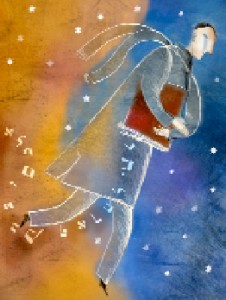Holidays
Purim
Commentary: Passing Through

Each holiday has a sibling; according to the rabbis, Purim is matched with Yom Kippur—biblically known as Yom Ha-kippurim. Kippurim is taken to mean “like Purim,” and there are many interpretations linking the two. Certainly, they are linked by teaching us about different kinds of danger. On Yom Kippur we are conscious of the internal threats to our integrity. Sin erodes the soul; repentance renews it.
On Purim, we remember external threats. Haman was not merely bad for the Jews, though they were the keystone to his destructive design. As with every truly evil person who aspires to leadership, Haman’s threat was a general one. His scheme would destroy the Jewish people first, but hardly last. Similarly, the great tyrants of the 20th century targeted Jews, but we were not the sole victims in the chain of disaster.
Purim reminds us that vigilance against external threats in general has a religious dimension. To be a Jew is not only to be concerned about Jews, but about the world. Urgent issues of war, oppression and slavery engage us as well. So do deeper issues of justice and equity both abroad and at home. Whatever one’s opinion of the “occupy” movement, economic conditions are a religious concern. The despair of joblessness and the anguish of poverty are not solely material conditions, but spiritual deprivations. Each day as resumés arrive in my office from congregants seeking work I am reminded that religion cannot be sealed off from the conditions of the society around us. We are not spiritual solipsists. Why did Mordecai warn the king of a plot against him? Because Mordecai knew that he had a responsibility as a citizen and a human being—not solely as a Jew—to tend to the health of his city.
So we react to the general health of our nation, but of course Purim also reminds us powerfully of the reality of anti-Semitism. When I was young, I recognized that my father, a rabbi, would only have to invoke the specter of anti-Semitism for his congregation to offer up their full attention. It was the great Jewish rallying cry. When I began my rabbinate, I was convinced that its relevance had faded. In America, that is still largely the case. But the renewal of anti-Semitism around the world lends Purim a pertinence we wish it did not have.
Ultimately, what ties Purim and Yom Kippur together is that each reminds us of our fragility and mortality. “As a passing shadow” teaches the “U’netaneh Tokef,” which is recited on the High Holidays; in youth, life seemed to stretch out before us. With each passing year the foreshortened horizon reminds us of the toll of time. Right before Purim we join in the Fast of Esther, Ta’anit Esther, because we identify with the fear she felt in coming before the king. Life is never without peril and each moment can be decisive. Yom Kippur and Purim symbolize the two dominant reactions to this unignorable reality: to repent and begin earnest attempts to live better, and to laugh and rejoice in the time we have. Threats to our integrity, our peoplehood and our society abound. To be a Jew is to respond to each with courage and faith.
There is a beautiful story about the Chofetz Chaim (Rabbi Israel Meir Kagan), the spiritual giant who lived in Radun, Belarus, in the 19th and early 20th century. Once a group of American tourists visited him and found him in his study, empty but for an old desk and some books. “Where are all your things?” they asked. “Where are yours?” he responded. “We are only passing through,” one of the tourists explained. The Chofetz Chaim answered, “Me, too.”
David Wolpe’s most recent book is Why Faith Matters: God and the New Atheism (HarperOne).








 Facebook
Facebook Instagram
Instagram Twitter
Twitter
Leave a Reply